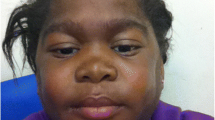Abstract
A boy born at full-term died after 14 days from cardiac failure. At autopsy DiGeorge complex was diagnosed. The father was found to have facial dysmorphia and hypocalcaemia. Investigations revealed no cause other than hypoparathyroidism associated with normal serum 1,25-dihydroxyvitamin D concentrations and normal renal handling of phosphate. Immunological tests, performed on two occasions with an interval of 9 months, revealed a decrease in the number of CD8+ lymphocytes, compatible with a partial thymus deficiency. The combination of facial dysmorphia with dysfunction of the thymus and the parathyroid glands can constitute a partial DiGeorge complex. The findings in this family are compared with reports of four other families with DiGeorge complex in two generations. In genetic counseling DiGeorge complex should be considered a heterogenous disorder. Screening of the parents for somatic stigmata, hypocalcaemia, disturbed cellular immunity, cardiac and chromosomal abnormalities is essential.
Similar content being viewed by others
Abbreviations
- ALS:
-
antilymphocyte serum
- cAMP:
-
cyclic adenosine monophosphate
- ConA:
-
conconavalin A
- MLR:
-
mixed lymphocyte reaction
- 1,25-(OH)2D:
-
1,25-dihydroxyvitamin D
- PBMC:
-
peripheral blood mononuclear cells
- PHA:
-
phytohaemagglutinin
- PTH:
-
parathyroid hormone
- PWM:
-
pokeweed mitogen
- TmP/GFR:
-
tubular maximal reabsorption of phosphate/glomerular filtration rate
References
Bijvoet OLM (1980) Measurements of renal handling of phosphate. In: Massry SG, Fleisch H (eds) Renal handling of phosphate. Plenum Press, New York, pp 1–37
Broadus AE, Mahaffey JE, Barter FC, Neer RM (1977) Nephrogenous cyclic adenosine monophosphate as a parathyroid function test. J Clin Invest 60:771–783
Carey JC (1980) Spectrum of the DiGeorge “syndrome”. J Pediatr 96:955–956
Conley ME, Beckwith JB, Mancer JFK, Tenckhoff L (1979) The spectrum of the DiGeorge syndrome. J Pediatr 94:883–890
De La Chapelle A, Herva R, Koivisto M, Aula P (1981) A deletion in chromosome 22 can cause DiGeorge syndrome. Hum Genet 57:253–256
Durandy A, Le Deist F, Fischer A, Griscelli C (1986) Impaired T8 lymphocyte-mediated suppressive activity in patients with partial DiGeorge syndrome. J Clin Immunol 6:265–270
Edelstein S, Charman M, Lawson DEM, Kodicek E (1974) Competitive binding assay for 25-hydroxycholecalciferol. Clin Sci Mol Med 46:231
Forsythe R (1981) Thymic aplasia in siblings. Pediatr Res 15:561
Gatti RA, Gershanik JJ, Levkoff AH, Wertelecki W (1972) DiGeorge syndrome associated with combined immunedeficiency. J Pediatr 81:920–926
Gidding SS, Minciotti AL, Langman CB (1988) Unmasking of hypoparathyroidismin familial partial DiGeorge syndrome by challenge with disodium edetate. N Engl J Med 319:1589–1591
Greenberg F, Ledbetter D, Kirkland J, Shearer W, Rosenblatt H (1986) A prospective clinical and cytogenetic study of DiGeorge sequence. Pediatr Res 20:325A
Ham Pong AJ, Cavallo A, Holman GH, Goldman AS (1985) DiGeorge syndrome: long-term survival complicated by Graves disease. J Pediatr 106:619–620
Jongen MTM, Vijgh WJF van der, Willems HJT, Netelenbos JC (1981) Analysis of 1,25-dihydroxy vitamin D in human plasma after liquid chromatographic purification procedure with a modified competitive protein binding assay. Clin Chem 27:444
Kelley RI, Zackai EH, Emanuel BS, Kistenmacher M, Greenberg F, Punnett HH (1982) The association of the DiGeorge anomalad with partial monosomy of chromosome 22. J Pediatr 101:197–200
Keppen LD, Fasules JW, Burks AW, Gollin SM, Sawyer JR, Miller CH (1988) Confirmation of autosomal dominant transmission of the DiGeorge malformation complex. J Pediatr 113:506–508
Lammer EJ, Opitz JM (1986) The Digeorge anomaly as a developmental field defect. Am J Med Genet [Suppl] 2:113–127
Lewin IG, Papapoulos SE, Tomlinson S, Hendy GN, O'Riordan JLH (1978) Studies of hypoparathyroidism and pseudohypoparathyroidism. Q J Med 47:553
Miller JD, Bowker BM, Cole DEC, Guyda HJ (1983) DiGeorge's syndrome in monozygotic twins. Am J Dis Child 137:438–440
Nieuwenhuijzen Kruseman AC, Froelich M, Walma ST, Valentijn RM (1987) Diagnostic value of intact parathyroid hormone measurements. Neth J Med 31:10
Nolten WE, Chesney RW, Dabbagh S, Lemann J, Slatopolsky E, Klingensmith GJ, DeLuca HF (1987) Moderate hypocalcemia due to normal serum 1,25-dihydroxyviatmin D levels in an asymptomatic kindred with familial hypoparathyroidism. Am J Med 82: 1157–1166
Oers MHJ van, Pinkster J, Zeylemaker WP (1979) Cooperative effects in mitogen and antigen induced responses of human peripheral blood lymphocyte subpopulations. Int Arch Allergy 58:53
Pabst HF, Wright WC, LeRiche J, Stiehm ER (1976) Partial DiGeorge syndrome with substantial cell-mediated immunity. Am J Dis Child 130:316–319
Raatikka M, Rapola J, Tuuteri L, Louhimo I, Savilahti E (1981) Familial third and fourth pharyngeal pouch syndrome with truncus arteriosus: DiGeorge syndrome. Pediatrics 67:173–175
Radl J, Hollander CF (1984) Homogeneous immunoglobins in the sera in mice during aging. J Immunol 112:2271–2273
Reinherz EL, Rosen FS (1980) Human immunodeficiency states resulting from disorders of T cell maturation and regulation. In: Seligmann M, Hitzig WH (eds) Primary immunodeficiencies. INSERM Symposium no. 16:109–117. Elsevier/North Holland, Amsterdam
Rohn RD, Leffell MS, Leadem P, Johnson D, Rubio T, Emanuel BS (1984) Familial third-fourth pharyngeal pouch syndrome with apparent autosomal dominant transmission. J Pediatr 105:47–51
Shepard MK, Linman SK (1976) Familial thymic aplasia with intrauterin growth retardation and fetal death: a new syndrome or a variant of DiGeorge syndrome. Birth Defects 12:123
Shprintzen RJ, Goldberg RB, Young D, Wolford L (1981) The velo-cardio-facial syndrome: a clinical and genetic analysis. Pediatrics 67:167–172
Steele RW, Limas C, Barrett DJ, Kiel E (1972) Familial thymic aplasia. N Engl J Med 287:787–791
Tovey KC, Oldham KG, Whelan JAM (1974) A simple direct assay for cyclic AMP in plasma and other biological samples using an improved competitive protein binding technique. Clin Chim Acta 56:221
Winter WE, Silverstein JH, Barrett DJ, Kiel E (1984) Familial DiGeorge syndrome with tetralogy of Fallot and prolonged survival. Eur J Pediatr 141:171–172
Author information
Authors and Affiliations
Rights and permissions
About this article
Cite this article
Maaswinkel-Mooij, P.D., Papapoulos, S.E., Gerritsen, E.J.A. et al. Facial dysmorphia, parathyroid and thymic dysfunction in the father of a newborn with the DiGeorge complex. Eur J Pediatr 149, 179–183 (1989). https://doi.org/10.1007/BF01958276
Received:
Accepted:
Issue Date:
DOI: https://doi.org/10.1007/BF01958276




